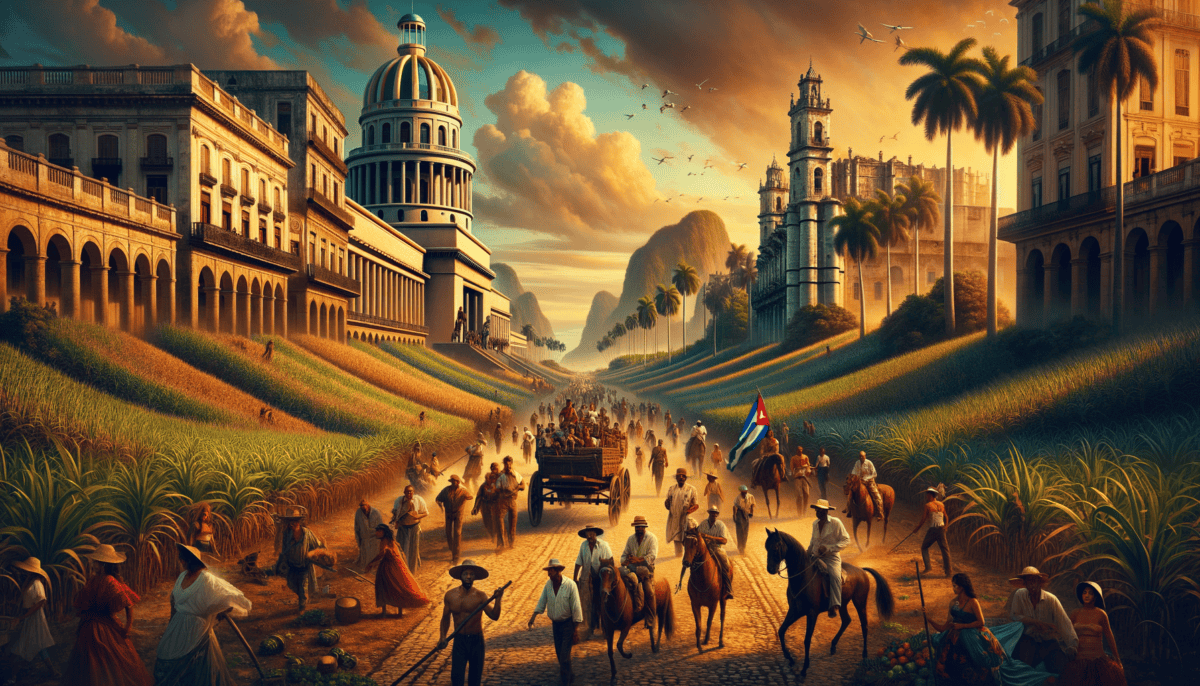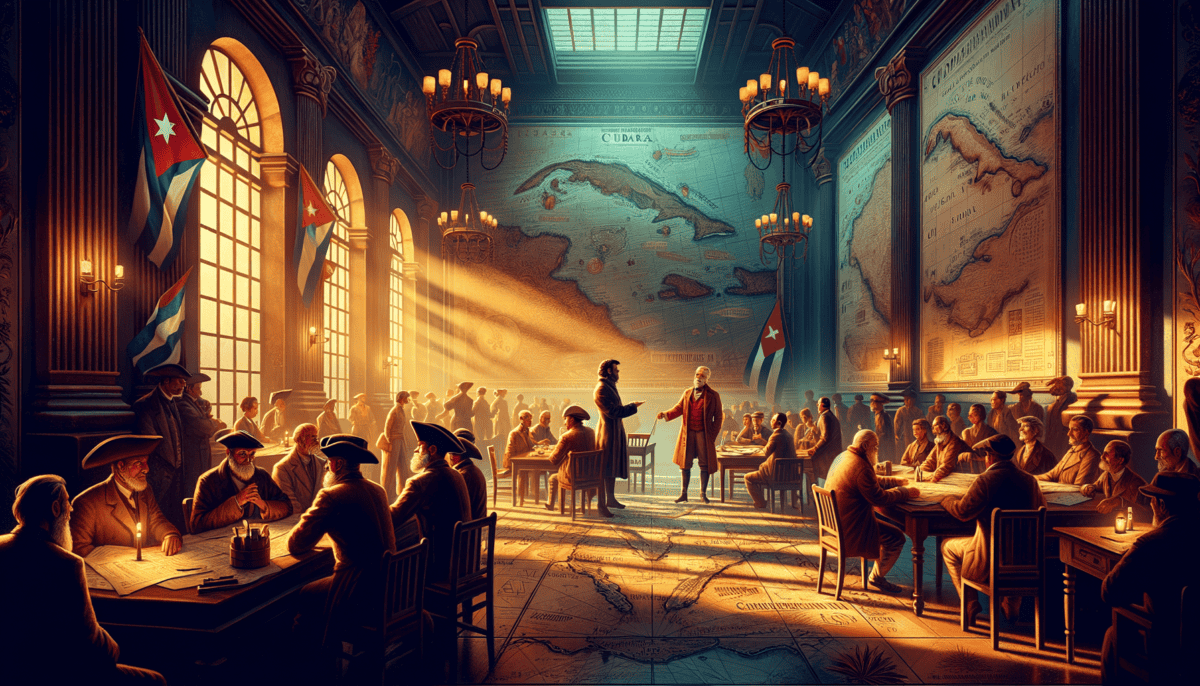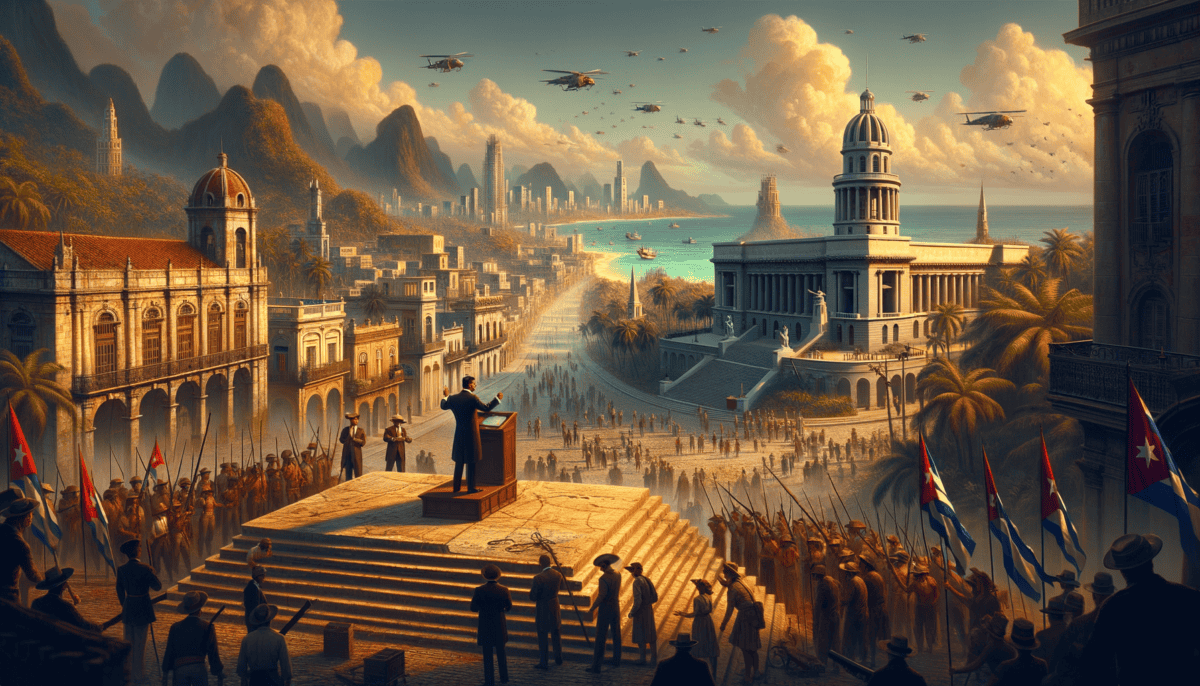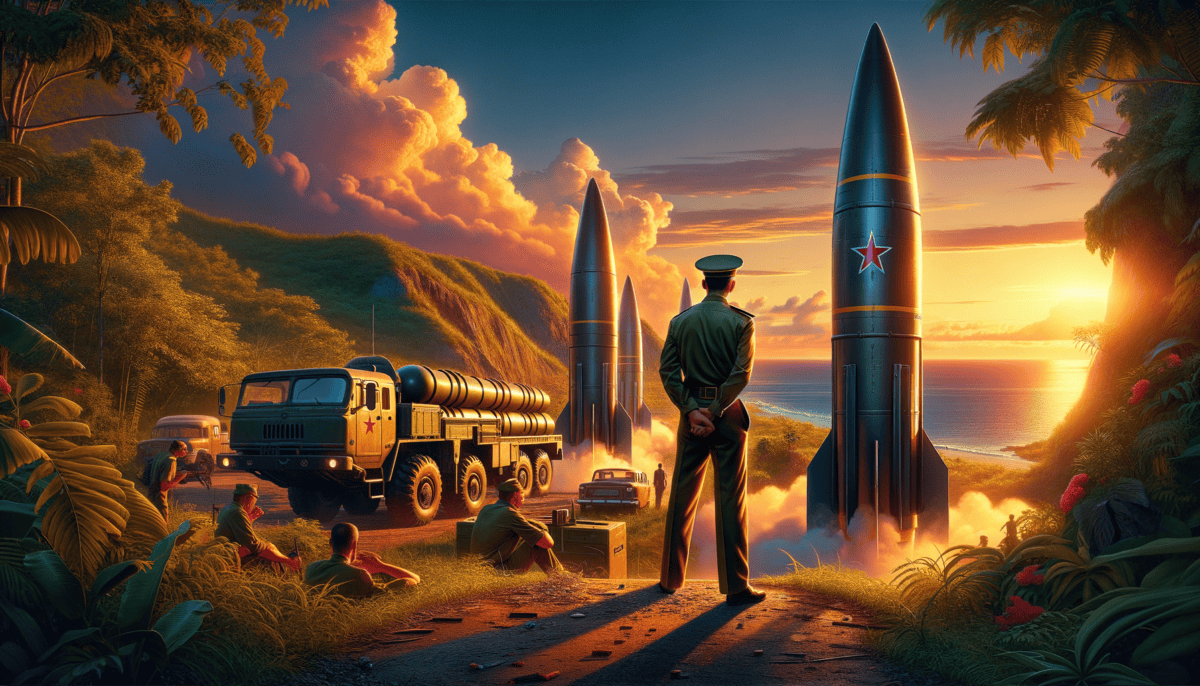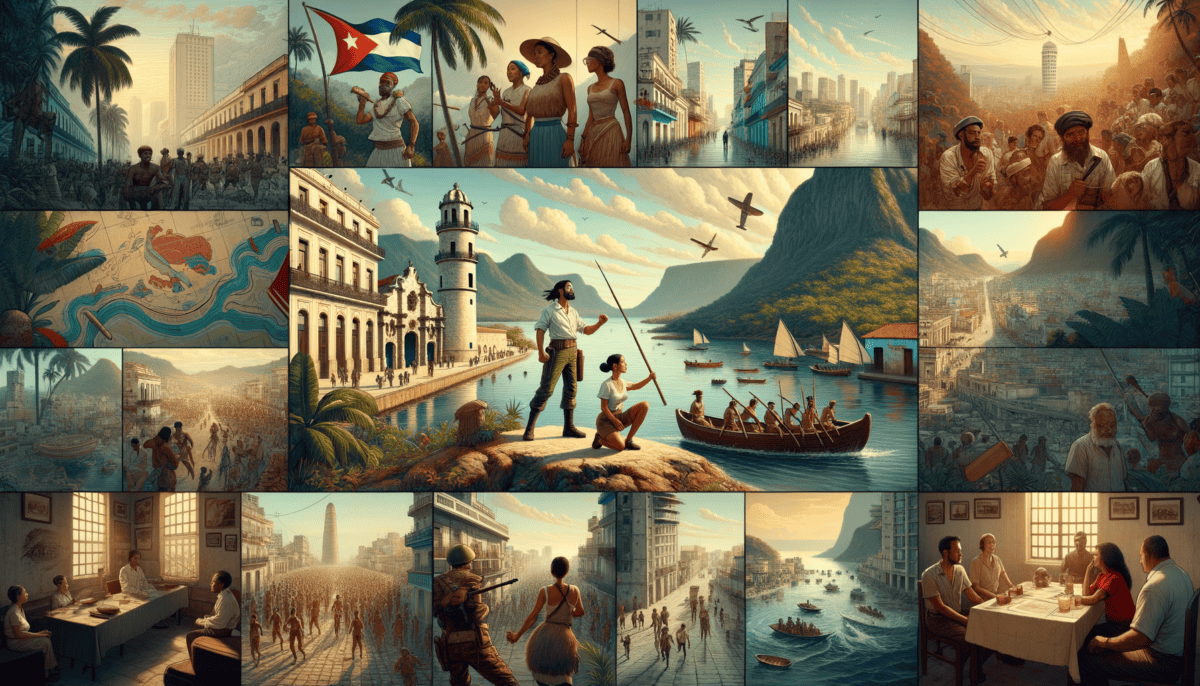Island of the Taínos
Long ago, on a beautiful island in the blue Caribbean Sea, lived a peaceful group of people called the Taínos. The sun smiled down on their home, which they called Cubanascán.
Little Hatuey, a Taíno boy with bright eyes, ran through the village one sunny morning. “Mama, look what I found!” he called out, holding up a shiny red fruit. His mother smiled, teaching him about the sweet guava that grew all around their home.
The Taínos lived simple but happy lives. They:
- Grew yuca and sweet potatoes
- Fished in crystal-clear waters
- Made beautiful pottery with pretty designs
- Lived in round houses called bohíos
- Played fun games with balls made from tree sap
A Day in Taíno Life
Every morning, the village came alive with activity. Women wove soft hammocks from cotton, while men paddled canoes to catch fish. Children played in the warm sand and helped gather fruits from tall trees.
“Our island gives us everything we need,” the village elder would say. “The sea brings us fish, the earth gives us food, and the sky watches over us all.”
One special evening, as the sun painted the sky orange and pink, the whole village gathered for a areíto – their special celebration. They danced and sang stories about their ancestors and their beloved island.
Strange Sails on the Horizon
Then one day in 1492, something different appeared in the distance. Big boats with white sails came closer to the shore. The Taínos had never seen anything like them before!
A man named Christopher Columbus and his sailors stepped onto the beach. They wore strange clothes and spoke words the Taínos didn’t understand. At first, everyone was curious and friendly.
“Welcome to our home,” the Taíno chief said through gestures of peace. The Spanish explorers looked around in wonder at the lush green forests and sparkling beaches.
Little Hatuey watched from behind a palm tree as these new people walked through his village. He didn’t know it yet, but this meeting would change life on the island forever.
The warm breeze rustled through the palm leaves as two very different worlds met for the first time on the shores of Cuba. A new chapter in the island’s story was just beginning.
Sugar, Slavery, and Spanish Rule
The big ships brought many changes to Cuba. The Spanish wanted to make the island their own. They built tall stone buildings and started huge farms called plantations.
Maria, a young Spanish girl, watched from her window as workers cut down the thick forests. “Papa, why are we changing the island?” she asked her father.
“We’re making it better, mi hija,” he said. But was it really better?
Life on the Sugar Plantations
The Spanish brought people from Africa to work on the sugar farms. These people didn’t come by choice – they were forced to come as slaves. It was a very sad time.
“Even in the hardest times, we kept our songs and stories alive,” an old woman would tell the children. “Our music helped us stay strong.”
The plantations grew bigger and bigger. Workers had to:
- Cut tall sugar cane in the hot sun ☀️
- Carry heavy loads to the sugar mills
- Work from sunrise to sunset
- Live in small, crowded houses
- Follow strict rules made by the Spanish
Brave Hearts Fight Back
But not everyone accepted this unfair life. Many brave people fought against slavery. They ran away to the mountains and made secret camps called palenques. ♂️
Carlos, a young boy whose parents worked on the plantation, would sometimes hear whispers of rebellion. “One day,” his mother would say softly, “things will change.”
A New Cuba Growing
As time passed, something new began to grow in Cuba. It wasn’t just sugar cane – it was a dream of freedom. People from Spain, Africa, and the few remaining Taínos started to mix together.
They created new music that mixed African drums with Spanish guitars. They made new foods that combined different spices and flavors. They told stories that belonged only to Cuba.
In the cities, people started talking about making Cuba free from Spain. They wanted to make their own rules and live without slavery. More and more people joined this dream of independence.
At night, when the sugar fields were quiet, you could hear the drums beating in the distance. They seemed to say, “Freedom is coming, freedom is coming…”
Dreams of Freedom
The sun rose over Cuba as José Martí walked through the streets of Havana. His heart was full of big dreams. “Our island should be free,” he would tell anyone who would listen.
The Fight Begins
Little Ana watched from her window as men gathered in the town square. “Mama, why are they meeting?” she asked.
“They’re planning for our freedom, mi amor,” her mother whispered. “They want Cuba to make its own choices.”
“Cuba needs to be free like a bird in the sky,” Martí would say. His words made people brave.
The fight for freedom wasn’t easy. Many heroes stepped forward:
- José Martí wrote poems about freedom
- Antonio Maceo led brave soldiers
- Máximo Gómez taught people how to fight
- Women carried secret messages
- Children helped by being lookouts
The Big War
Soon, a big war started. The people of Cuba wanted to be free from Spain. They fought in the forests and mountains. ️
Miguel, a young messenger boy, ran through the streets with important news. “The Americans are coming to help!” he shouted. The United States joined the fight against Spain.
Victory and Change
After many battles, Cuba finally won its freedom from Spain in 1898. People danced in the streets! They waved new Cuban flags with bright stars and stripes.
“We are free!” they shouted. “¡Viva Cuba Libre!” (Long live free Cuba!)
A New Beginning
Cuba started to build its own government. Children went to new schools. Farmers could grow what they wanted. Musicians played Cuban songs in the streets.
“Now we can make Cuba the way we want it,” old Pedro told the children in the park. “We can write our own story.”
The warm Caribbean wind carried the smell of freedom through the palm trees. Cuba was changing again, but this time, the people were in charge of their destiny.
As the sun set over Havana harbor, little Ana asked her mother, “What happens next?”
Her mother smiled and said, “We write our own story now, mi amor. We write it together.” ✨
Winds of Change
A new wave of change swept across Cuba. The year was 1953, and a young lawyer named Fidel Castro had big dreams. He wanted to make life better for all Cubans.
The Young Rebels
“Look at those brave young people,” whispered Maria to her brother Luis. They watched as Fidel and his friends planned their big move. These rebels wanted to make Cuba fair for everyone.
A special friend joined Fidel. His name was Che Guevara, a doctor from Argentina. He had a kind heart and wanted to help sick people. Together, they made a strong team.
“We must fight for a better Cuba,” Fidel would say. His words gave people hope.
The rebels had different jobs to do:
- Some taught people to read
- Others helped sick people get better
- Many fought for farmers’ rights
- Some shared food with hungry families
- Everyone worked together for change
The Big Change
The rebels lived in the mountains called Sierra Maestra. They wore green uniforms and had long beards. More and more people joined them every day. ️
Little Rosa listened to Radio Rebelde with her family. “Papa, are things really going to get better?” she asked.
“Yes, mi pequeña,” her father smiled. “Change is coming.”
A New Cuba
On January 1, 1959, something big happened. Fidel and the rebels won! They rode into Havana on big trucks. People threw flowers and cheered.
Growing Pains
But not everything was easy. Some people didn’t like the changes. The United States was worried about Cuba’s new friends in the Soviet Union. Things got complicated.
“Why can’t everyone just get along?” Rosa asked her mother one night.
“Sometimes big changes are hard, mi amor,” her mother explained. “But we must be brave.”
The stars shone bright over Havana Bay. In homes across Cuba, families talked about their hopes and fears. Cuba was writing a new chapter in its story.
“What do you think will happen next?” Luis asked his sister Maria.
She looked at the stars and said, “We’ll have to be strong and see.” ✨
Days of Crisis
The sun rose over Havana one morning in 1962. Little Marco watched ships in the harbor through his telescope. “Papa, why are there so many ships today?” he asked.
Worried Faces
Marco’s mother kept the radio on all day. His father checked the sky more than usual. Everyone seemed worried. Even Marco’s teacher at school talked differently.
“The whole world is watching Cuba now,” Marco’s father said softly.
The crisis brought many changes:
- More soldiers on the streets
- Special drills at school
- Families storing extra food
- New radio announcements
- Planes flying overhead often
Tense Times
“Why is everyone so scared?” Marco asked his grandmother one evening.
“Sometimes grown-ups forget how to talk nicely to each other,” she explained, holding his hand. “But we must stay strong.”
Hope in Hard Times
Life changed during these days. Marco’s family stayed close together. They played games at night and told stories. Friends shared food and helped each other.
“Look at the stars, Marco,” his mother said one night. “They still shine, no matter what.”
New Friends and Old Problems
The Soviet Union became Cuba’s big friend. They sent food, machines, and help. But the United States stopped talking to Cuba. This made things hard.
Brave Hearts
The crisis ended after 13 scary days. People cried happy tears. Kids played in the streets again. Life slowly went back to normal.
“We are stronger now,” Marco’s teacher told the class. “We learned how brave we can be.”
“What makes us special?” Marco asked his father one evening.
“Our big hearts,” his father smiled. “And how we take care of each other.” ❤️
The stars still shone over Havana. Music still played in the streets. And Cuban people kept dancing, singing, and dreaming of tomorrow. ✨
Dreams of Tomorrow
The warm Caribbean breeze dances through Old Havana today. Bright colors paint the buildings like a rainbow. Music fills the streets with joy.
Fresh Changes
Little Ana walks with her grandmother down the busy street. “Look!” she points excitedly. “A new restaurant!”
“Yes, mi amor,” her grandmother smiles. “Now people can open their own small businesses. Things are different from when I was young.”
Ana sees many new things in her neighborhood:
- Internet cafes with computers
- Tourist shops selling crafts
- Food trucks with tasty treats
- Art galleries showing paintings
- Musicians playing on corners
Keeping Traditions
“Tell me about the old days, Abuela,” Ana asks as they share ice cream.
“We had less things then,” her grandmother says, “but we always had each other. That’s what makes Cuba special.”
Building Bridges
Cuba is making new friends around the world. More visitors come to see the island. Cuban doctors help other countries. Students learn new things.
Hope Blooms
Young people like Ana dream big dreams. They learn English, study computers, and think of new ideas. Some start small businesses. Others make art or music.
Tomorrow’s Promise
As the sun sets over Havana, Ana and her grandmother sit on their balcony. They watch people walking below, hear children laughing, smell dinner cooking.
“Cuba is changing,” her grandmother says, “but our hearts stay strong. We keep dancing, singing, and loving each other.”
“What will Cuba be like when I grow up?” Ana asks.
Her grandmother hugs her tight. “It will be whatever we make it, mi amor. Our story continues, and you will help write it.” ❤️
As stars twinkle over the island, Cuba’s story goes on. New dreams bloom like flowers in the warm Caribbean sun. The future holds many adventures, and Cuba faces them with hope, strength, and its ever-dancing spirit. ✨


